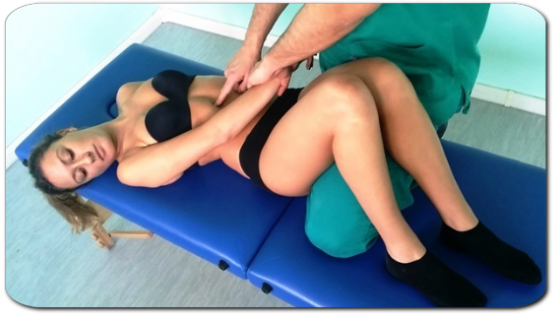Technique
Counterstrain
Strain Counterstrain Technique®
Strain Counterstrain technique is a gentle, osteopathic manual approach which consists of a passive, repositioning neurological procedure that places the body in a position of great comfort. This passive repositioning will relieve pain and dysfunction by reducing and halting the inappropriate proprioceptor activity that maintains the somatic dysfunction in any area of the body. The technique consists of a mild overstretching applied in the opposite direction to the false and continual strain indication. For more information concerning this topic, download Chapter 13 in PDF or in the Italian e-book from the book: Rational Manual Therapies by John V Basmajian and Rich Nyberg by Randall S. Kusunose.
The diagnosis of a clinic which utilizes a Strain-Counterstrain (SCS) clinician is oriented by the identification of specific small zones of tension in tender tissue throughout the body, called Tender Points (TP) which will guide the operator in the evaluation and treatment strategy. The ideal position exists where there is a reduction of at least two-thirds of the Tender Points, indicating the correct positioning of the body.


Training in Strain-Counterstrain will completely revolutionize the concept of manual medicine. The specific instruction of somatic neurological dysfunction will allow participants to immediately appreciate, from a personal standpoint, the profound impact of the technique. Thanks to the noteworthy in-depth analysis of notions furnished by the course and knowledge of the most recent discoveries in the neurophysiological sector, we set one’s sights on the objective of: developing the skills of professionals and to train, in an efficient manner, the participants in use of the most essential skills. Upon conclusion of the course, participants will be able to immediately practice the following acquired techniques in an autonomous manner: “scanning” the entire rachis; configuration of a proper examination, quickly constructing a therapeutic plan which will be utilized in future visits. Participants will consider and learn how to correct, using various techniques, more than 270 muscular-skeletal dysfunctions. Participants will treat, with immediate success, problems with which they previously experienced major difficulties or limited success, above all with methods which are immediate and long-term and totally free of pain and non-traumatic for the patient. Likewise, participants will gain the capacity to understand pathological conditions which necessitate collaboration with other medical specialists.
The Strain Counterstrain (SCS) technique can accompany your technique improving palpable skills and increase the effectiveness of your manual medicine techniques such as: Muscle Energy, HVLI, Myofascial Release, Functional Technique, Muscle Chain Technique, Postural Reprogramming Techniques, Visceral Techniques, Deep Muscle Transverse Friction, Stretching and Exercise.
The therapeutic uses for Strain-Counterstrain (SCS) is broad and ranges from acute injuries to chronic pain, osteoporotic, post-operative and OB patients, pregnant, pediatric, neurologic issues and full joint replacement patients as well.
The benefits of this technique are immediate for the patient who can instantly feel the release or balance regain in the treated area. The Strain-Counterstrain technique can be applied to every region of the body in a non-invasive manner. Acute patients have a formidable response to the gentile technique procedure. Chronic patients can achieve remarkable results when other techniques have failed.
Every position is held in the correct treatment pose for just 90 seconds and then resumed to the proper physiological position in a smooth and deliberate way before choosing another area of dysfunction. Usually with a single position, the therapist can shut down multiple TP (tender points). The correct sequencing of treatment will cover the entire evaluation of multiple structure dysfunction and treat them one after another in order to bring back the equilibrium of tissue.
In our courses: The various TP are deeply taught from the theoretical and practical point of view, in order to have a very clear idea of: the localization, the palpable sensation for every TP, pain component and its projection elsewhere, and eventual pathology linked with various TP, and the antalgic posture assumed by the patient for every dysfunction and the technique to reestablish the physiologic homeostasis of the dysfunction segment.
Practical use of Strain Counterstrain:
.
THE PECULIARITY OF THE TECHNIQUE ARE:
the areas of primary and secondary dysfunction, where to begin, how to proceed, how the therapy is really going and how many visits will be
necessary to conclude the treatment plan.
second of execution.
 Work autonomously after each individual course.
Work autonomously after each individual course.
 Utilize an absolutely pain-free and non-traumatic manual technique.
Utilize an absolutely pain-free and non-traumatic manual technique.
 Use a technique which has zero contraindications regardless of the type of patient.
Use a technique which has zero contraindications regardless of the type of patient.
 Evaluate the precise state of the articular dysfunction through this unique osteopathic system and the diagnostic points termed ‘Tender
Evaluate the precise state of the articular dysfunction through this unique osteopathic system and the diagnostic points termed ‘Tender
Points’ by Dr. Jones.
 A unique method which identifies specific areas on the anterior surface of the body, related to dysfunctions and pain on the posterior side.
A unique method which identifies specific areas on the anterior surface of the body, related to dysfunctions and pain on the posterior side.
apparatus, the craniofacial apparatus, the visceral pleura, the peripheral nervous system (PNS), the arterial and lymphatic systems and all of the
contractile innervated structures.
improvements in the technique, while maintaining its originality.
 Numerous clinical studies, scientific publications and bibliographies on the subject.
Numerous clinical studies, scientific publications and bibliographies on the subject.

